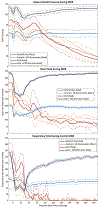Carotid body stimulation as a potential intervention in sudden death in epilepsy
- PMID: 36202052
- PMCID: PMC10187768
- DOI: 10.1016/j.yebeh.2022.108918
Carotid body stimulation as a potential intervention in sudden death in epilepsy
Abstract
Objective: To investigate carotid body (CB) mechanisms related to sudden death during seizure. Ictal activation of oxygen-conserving reflexes (OCRs) can trigger fatal cardiorespiratory collapse in seizing rats, which presents like human sudden unexpected death in epilepsy (SUDEP). The CB is strongly implicated in OCR pathways; we hypothesize that modulating CB activity will provide insight into these mechanisms of death.
Methods: Long-Evans rats were anesthetized with urethane. Recordings included: electrocorticography, electrocardiography, respiration via nasal thermocouple, and blood pressure (BP). The mammalian diving reflex (MDR) was activated by cold water delivered through a nasal cannula. Reflex and stimulation trials were repeated up to 16 times (4 pre-intervention, 12 post-intervention) or until death. In some animals, one or both carotid bodies were denervated. In some animals, the CB was electrically stimulated, both with and without MDR. Seizures were induced with kainic acid (KA).
Results: Animals without seizure and with no CB modulation survived all reflexes. Non-seizing animals with CB denervation survived 7.1 ± 5.4 reflexes before death, and only 1 of 7 survived past the 12-trial threshold. Electrical CB stimulation without seizure and without reflex caused significant tachypnea and hypotension. Electrical CB stimulation with seizure and without reflex required higher amplitudes to replicate the physiological responses seen outside seizure. Seizing animals without CB intervention survived 3.2 ± 3.6 trials (per-reflex survival rate 42.0% ± 44.4%), and 0 of 7 survived past the 12-trial threshold. Seizing animals with electrical CB stimulation survived 10.5 ± 4.7 ictal trials (per-reflex survival rate 86.3% ± 35.0%), and 6 of 8 survived past the 12-trial threshold.
Significance: These results suggest that, during seizure, the ability of the CB to stimulate a restart of respiration is impaired. The CB and its afferents may be relevant to fatal ictal apnea and SUDEP in humans, and CB stimulation may be a relevant intervention technique in these deaths.
Keywords: Carotid sinus nerve; Diving reflex; Ictal apnea; SUDEP; Seizure.
Copyright © 2022 Elsevier Inc. All rights reserved.
Conflict of interest statement
Declaration of Competing Interest None of the authors has any conflict of interest to disclose. We confirm that we have read the Journal’s position on issues involved in ethical publication and affirm that this report is consistent with those guidelines.
Figures






Similar articles
-
Ictal activation of oxygen-conserving reflexes as a mechanism for sudden death in epilepsy.Epilepsia. 2021 Mar;62(3):752-764. doi: 10.1111/epi.16831. Epub 2021 Feb 11. Epilepsia. 2021. PMID: 33570173 Free PMC article.
-
Utilizing multimodal imaging to visualize potential mechanism for sudden death in epilepsy.Epilepsy Behav. 2021 Sep;122:108124. doi: 10.1016/j.yebeh.2021.108124. Epub 2021 Jul 5. Epilepsy Behav. 2021. PMID: 34237676 Free PMC article.
-
Mechanisms and prevention of acid reflux induced laryngospasm in seizing rats.Epilepsy Behav. 2020 Oct;111:107188. doi: 10.1016/j.yebeh.2020.107188. Epub 2020 Jun 12. Epilepsy Behav. 2020. PMID: 32540771 Free PMC article.
-
Toward automated prediction of sudden unexpected death in epilepsy.Rev Neurosci. 2022 May 27;33(8):877-887. doi: 10.1515/revneuro-2022-0024. Print 2022 Dec 16. Rev Neurosci. 2022. PMID: 35619127 Review.
-
A unified hypothesis of SUDEP: Seizure-induced respiratory depression induced by adenosine may lead to SUDEP but can be prevented by autoresuscitation and other restorative respiratory response mechanisms mediated by the action of serotonin on the periaqueductal gray.Epilepsia. 2023 Apr;64(4):779-796. doi: 10.1111/epi.17521. Epub 2023 Feb 15. Epilepsia. 2023. PMID: 36715572 Free PMC article. Review.
Cited by
-
Sudden unexpected death in epilepsy.Curr Opin Neurol. 2022 Apr 1;35(2):181-188. doi: 10.1097/WCO.0000000000001034. Curr Opin Neurol. 2022. PMID: 35102124 Free PMC article. Review.
-
Challenges and future directions of SUDEP models.Lab Anim (NY). 2024 Sep;53(9):226-243. doi: 10.1038/s41684-024-01426-y. Epub 2024 Aug 26. Lab Anim (NY). 2024. PMID: 39187733 Review.
-
The mechanism of sudden unexpected death in epilepsy: A mini review.Front Neurol. 2023 Feb 6;14:1137182. doi: 10.3389/fneur.2023.1137182. eCollection 2023. Front Neurol. 2023. PMID: 36815002 Free PMC article. Review.
-
Bioelectronic modulation of carotid sinus nerve to treat type 2 diabetes: current knowledge and future perspectives.Front Neurosci. 2024 Apr 5;18:1378473. doi: 10.3389/fnins.2024.1378473. eCollection 2024. Front Neurosci. 2024. PMID: 38646610 Free PMC article. Review.
-
High density probes reveal medullary seizure and rapid medullary shutdown in a model of fatal apnea in seizure.bioRxiv [Preprint]. 2025 Feb 13:2025.02.10.637524. doi: 10.1101/2025.02.10.637524. bioRxiv. 2025. PMID: 39990313 Free PMC article. Preprint.
References
-
- Ryvlin P, Nashef L, Lhatoo SD, Bateman LM, Bird J, Bleasel A, et al. Incidence and mechanisms of cardiorespiratory arrests in epilepsy monitoring units (MORTEMUS): a retrospective study. Lancet Neurol 2013;12(10):966–77. - PubMed
Publication types
MeSH terms
Grants and funding
LinkOut - more resources
Full Text Sources
Medical
Miscellaneous

